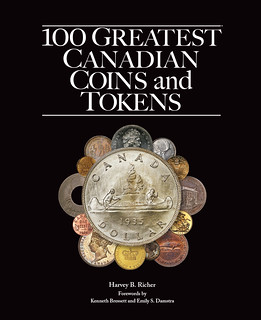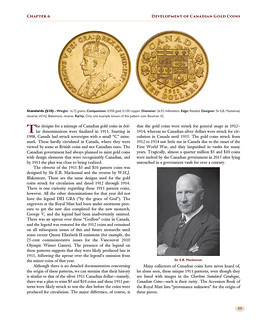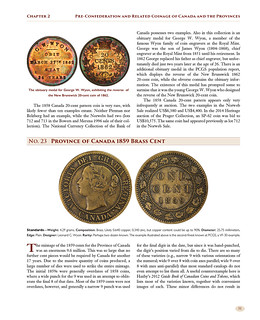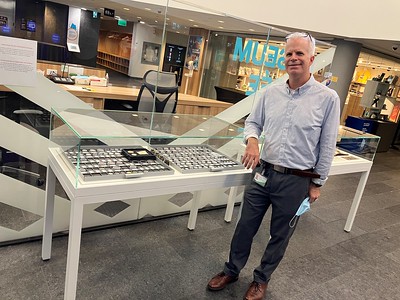
PREV ARTICLE
NEXT ARTICLE
FULL ISSUE
PREV FULL ISSUE
V25 2022 INDEX E-SYLUM ARCHIVE WRITING 100 GREATEST CANADIAN COINS AND TOKENSIn this Whitman press release, author Dr. Harvey Richer discusses his experience writing his book, 100 Greatest Canadian Coins and Tokens. -Editor
Early in the research for 100 Greatest Canadian Coins and Tokens, David Bergeron, the president of the CNRS and current curator of the National Currency Collection of the Bank of Canada, polled the members of the society at my suggestion, asking them to name up to five of their favorite coins and tokens related to Canada. A number of very useful suggestions were proffered by the group, and about half a dozen that I had not originally chosen were included in the final list. In the end, however, the choices were largely mine.
Those well versed in Canadian numismatics may find some of the entries in my anthology a bit odd, such as wampum belts, a U.S. encased postage stamp, a Government of Newfoundland $25 bond, a very common 1938 Newfoundland 1-cent coin, counterstamped Canadian dollars, and a number of high-mintage Canadian commemorative silver dollars. It may be fair to say some of these are not even coins or tokens, and as such do not belong. But each of these selections has a wonderful story to tell related to the development of Canadian coinage, and that is what most interested me in writing this book. Of course, all the high-priced, famous Canadian coins are here, too: the 1911 silver dollar, once called the world's most expensive coin; the gold $10 and $20 pieces from British Columbia; the 1890-H (the Instead of ordering the coins or tokens by some criterion of greatness (for example, recent auction prices or total number of examples known), I chose to produce a more or less chronological ranking. In this way, you can make historical connections between the various entries and follow, in a more continuous and comprehensive manner, the development of Canadian coinage from the earliest examples of wampum—used in trade among the Indigenous population and later with Europeans—all the way to Canadian coinage after Confederation, when Canada had its own mint and was a member of the British Commonwealth of Nations. All the physical specifications, auction details, pricing, and rarity information are included for each entry, but the narrative is a historical one. While the title of my anthology is 100 Greatest Canadian Coins and Tokens, the book contains many more than 100 individual coins and tokens. This is because several coins and tokens have been treated in a single essay both for clarity and to reduce duplication. For example, each of the three 1936 Dot coins clearly deserves its own unique entry, but this would be unduly repetitive. Additionally, only a few examples of major varieties were included (for example, Flat Top and Round Top 1893 10 cents), and less dramatic varieties generally did not find their way into the final compilation. Ranking the 100 Greatest Canadian Coins and Tokens No one person should decide on the ranking of anything, let alone something as controversial as the 100 greatest coins or tokens of any country. Collectors have their own favorite areas regarding what appeals to them, from a historical perspective or because of scarcity or availability, while dealers often pursue those coins that they believe can be resold at a profit. These would introduce very different biases into the selection of the greatest coins and tokens, so I decided to let a knowledgeable cross-section of the community do this hard work for me. I contacted a number of dealers and collectors whom I knew and asked them to contribute to the ranking process. The members of the Canadian Numismatic Research Society—the group mentioned above, of Canadians interested in the history and promotion of Canadian numismatics—were also asked to rank the entries in the book. I sent all these individuals a list of the 100 entries ordered more or less chronologically, as they currently appear in the book. The rules were few and simple:
1. No new additions allowed at this ranking stage.
Not surprisingly, the 1911 pattern silver dollar was ranked the number 1 Canadian coin or token—identical to its ranking in 100 Greatest Modern World Coins (by Charles Morgan and Hubert Walker). In fact, it would have been a surprise if the 1911 pattern dollar had not achieved this exalted position. (At one point it carried the moniker of the I am indebted to the following individuals for providing their ranking choices and sharing their knowledge and experience with the collecting community: Darryl Atchison, David Bergeron, Sandy Campbell, Clément Chapados-Girard, John Deyell, Michael Findlay, Robert Forbes, Michael Joffre, Greg Jones, Robert Kokotailo, Svetolik Kovacevic, Warren Long, Oliver M., George Manz, Andrew McKaig, Barry Renwick, David Rubin, Dale Schaffer, Jared Stapleton, and Rob Turner. David Bergeron, president of the Canadian Numismatic Research Society and curator of the National Currency Collection of the Bank of Canada. The Bank hosted a display of the greatest Canadian coins and tokens during the July 2022 RCNA convention. (Photo courtesy of Harvey Richer)
# # #
100 Greatest Canadian Coins and Tokens
To read the earlier E-Sylum article, see:
Wayne Homren, Editor The Numismatic Bibliomania Society is a non-profit organization promoting numismatic literature. See our web site at coinbooks.org. To submit items for publication in The E-Sylum, write to the Editor at this address: whomren@gmail.com To subscribe go to: https://my.binhost.com/lists/listinfo/esylum All Rights Reserved. NBS Home Page Contact the NBS webmaster 
|





